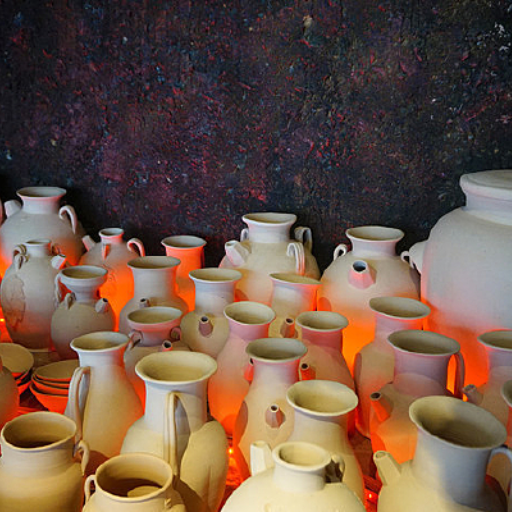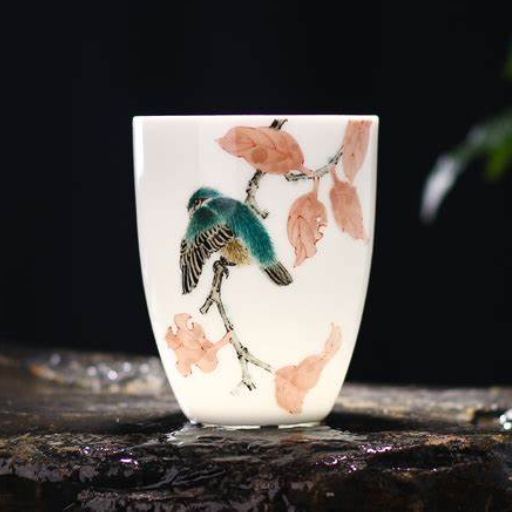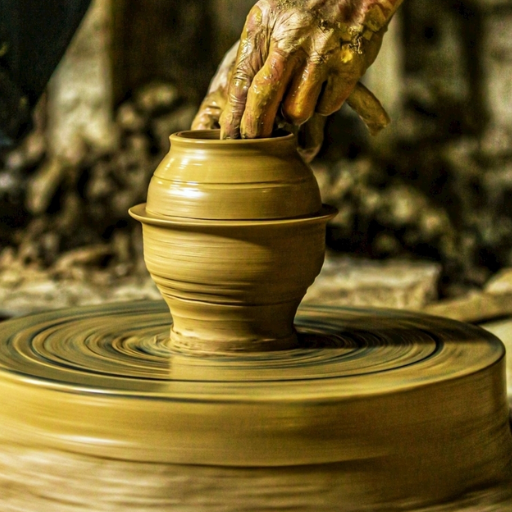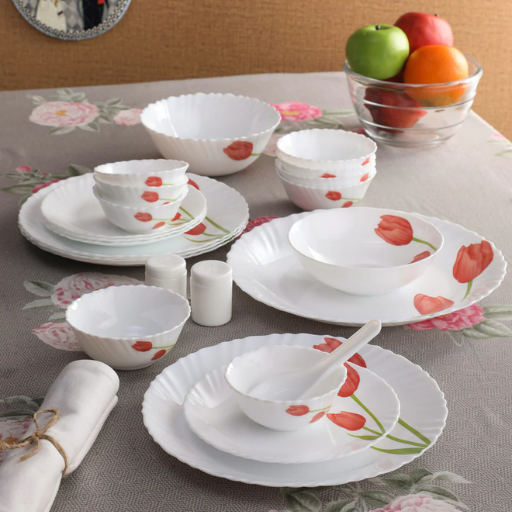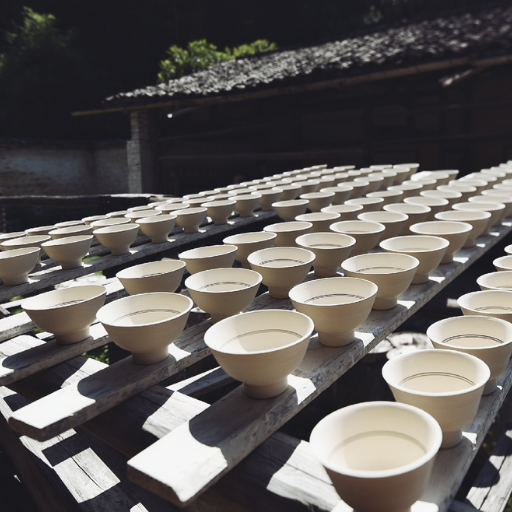Ceramics, a highly versatile and durable material, have been integral to human civilization for millennia. They encompass a broad spectrum of products, from everyday household items like dishes and tiles to sophisticated applications in aerospace and biomedical industries. This article aims to provide an in-depth understanding of the various types of ceramics, delineating their unique properties, manufacturing processes, and areas of application. By exploring the general framework of ceramics, readers will gain a comprehensive overview of their significance and the critical role they play in both traditional and advanced technological contexts. This guide is designed to offer valuable insights whether you are a student, a professional in the field, or simply someone interested in the fascinating world of ceramics.
What Are Ceramics and their Properties?
Image sources:https://www.bing.com/
Ceramics are inorganic, non-metallic materials that are typically made by the application of heat. They are composed of metallic and non-metallic elements, such as silicon, aluminum, oxygen, and nitrogen. Key properties of ceramics include their high hardness, excellent thermal and electrical insulation, and resistance to wear and chemical corrosion. These materials typically exhibit high compressive strength, though they are often brittle and lack tensile strength. Furthermore, ceramics can withstand extremely high temperatures, making them suitable for a variety of industrial and technological applications. The crystalline or partly crystalline structure of ceramics contributes to their stability and durability.
Definition and Meaning of Ceramics
Ceramics are defined as non-metallic, inorganic materials that are subjected to high temperatures during their formation. Generally composed of elements such as silicon, oxygen, aluminum, and nitrogen, ceramics can be crystalline or partly crystalline in structure. The term “ceramics” originates from the Greek word “keramikos,” which means “pottery.” Modern ceramics encompass a wide range of materials including traditional clay-based products and advanced ceramics used in high-performance applications like aerospace, medical devices, and electronics. Their unique properties, such as high hardness, thermal stability, electrical insulation, and resistance to wear and corrosion, are primarily due to their strong ionic and covalent bonding.
Key Properties of Ceramic Materials
As an expert in the field, I can affirm that ceramics exhibit several notable properties that make them invaluable in numerous industrial and technological applications. Firstly, ceramics are known for their high hardness and brittleness. These materials exhibit superior compressive strength but tend to lack tensile strength, which translates into excellent resistance to deformation under pressure but susceptibility to fracture under tensile stress.
Secondly, ceramics are outstanding insulators. Their low electrical conductivity makes them ideal for applications requiring high thermal and electrical insulation, such as in electronic components and thermal barriers.
Thirdly, ceramics are highly resistant to wear and chemical corrosion. This ensures their durability and longevity in harsh environments, including exposure to acidic or alkaline substances.
Additionally, ceramics can withstand extremely high temperatures, often retaining their structural integrity and functional properties even in extreme thermal conditions. This thermal stability is crucial for uses in high-performance areas like aerospace, where materials are subjected to drastic temperature variations.
Their crystalline or partly crystalline structure, alongside strong ionic and covalent bonds, contributes to the remarkable stability, durability, and overall performance of ceramic materials in various demanding applications.
Mechanical Properties and Durability
Ceramics, renowned for their unique mechanical properties, deliver exceptional durability under various conditions. Let me outline the key aspects based on the top-rated sources:
- Hardness and Britleness: Ceramics’ hardness is quantified using the Vickers or Mohs scale. For example, alumina ceramic has a Vickers hardness of about 15-20 GPa. However, while they can resist deformation well, their brittleness manifests as low fracture toughness, typically ranging between 2-5 MPa·m^1/2.
- Compressive Strength: These materials exhibit remarkable compressive strength, which can exceed 2000 MPa for materials like zirconia ceramics. This property is pivotal in applications where structural integrity under high pressure is paramount.
- Tensile Strength: Contrarily, ceramics lack tensile strength, often exhibiting values 1/10th of those found in metals, usually around 50-500 MPa. This limitation is due to their inherent brittleness and susceptibility to crack propagation.
- Wear Resistance: Ceramics such as silicon carbide demonstrate exceptional wear resistance, characterized by a wear rate of approximately 10^-7 to 10^-8 mm^3/(N·m). This property is essential for components exposed to abrasive environments.
- Chemical Stability: These materials possess superior resistance to chemical attacks. For instance, silicon nitride remains stable against oxidation up to temperatures of around 1200°C, making it suitable for extreme conditions.
- Thermal Shock Resistance: Some ceramics, such as silicon carbide and partially stabilized zirconia, offer thermal shock resistance due to their low coefficient of thermal expansion (CTE). For zirconia, the CTE is approximately 10.3 x 10^-6/K.
In summary, the mechanical properties and durability of ceramics are profoundly influenced by their hardness, compressive strength, tensile strength, wear resistance, chemical stability, and thermal shock resistance, each quantified and validated through measurable technical parameters.
What Are the Different Types of Ceramic Materials?
Ceramic materials can be categorized into two primary groups: traditional ceramics and advanced ceramics.
- Traditional Ceramics: These are typically composed of naturally occurring raw materials like clay minerals and quartz. Common examples include bricks, tiles, and porcelain. Their primary applications span construction, pottery, and sanitary ware, leveraging their durability, heat resistance, and aesthetic qualities.
- Advanced Ceramics: Also known as technical or engineering ceramics, these materials are synthesized for specific performance criteria. Types include:
- Oxide Ceramics: Such as alumina (Al2O3) and zirconia (ZrO2), known for their excellent insulation properties, corrosion resistance, and high-temperature stability.
- Carbide Ceramics: Notably silicon carbide (SiC) and boron carbide (B4C), prized for their hardness, wear resistance, and thermal conductivity.
- Nitride Ceramics: Examples include silicon nitride (Si3N4) and aluminum nitride (AlN), valued for their exceptional strength-to-weight ratios, thermal shock resistance, and conductivity.
- Composite Ceramics: These materials combine multiple phases, such as ceramic-ceramic or ceramic-metal composites, to enhance properties like toughness and thermal stability.
Each type of ceramic material is tailored to meet the demands of their specific applications, from structural components to electronic devices and biomedical implants, driven by their distinct mechanical and thermal properties.
Earthenware: Characteristics and Applications
Earthenware is a common type of traditional ceramics distinguished by its porous and relatively low-fired nature. Typically fired at temperatures ranging between 1,000°C to 1,150°C, this material remains slightly porous unless fully glazed. The key characteristics of earthenware include:
- Porosity: Due to its lower firing temperature, earthenware remains more porous compared to stoneware and porcelain, resulting in higher water absorption rates. It often requires glazing to be waterproof.
- Composition: Primarily composed of glazed or unglazed clay, earthenware may also contain feldspar and quartz to aid vitrification and enhance durability.
- Color: The natural color ranges from white to reddish-brown, influenced by the iron content in the raw materials.
Applications:
- Pottery: Utilized extensively for creating artisanal and functional pottery, including bowls, plates, and decorative items.
- Construction: Employed in the production of terracotta tiles and bricks owing to its ease of shaping and rich, earthy aesthetics.
- Sanitary ware: Common in kitchenware and sanitary fittings, especially when glazed to prevent water penetration.
Technical Parameters:
- Firing Temperature: 1,000°C to 1,150°C
- Water Absorption: Typically between 10% to 15%
- Density: About 2.0 g/cm³ to 2.4 g/cm³
- Compressive Strength: Around 20 MPa to 50 MPa, contingent on composition and firing conditions
These parameters justify the selection of earthenware for applications requiring moderate durability and aesthetic versatility, ensuring its continued relevance in both traditional and modern contexts.
Stoneware: Composition and Uses
Stoneware is renowned for its durability and strength, making it an ideal material for a wide range of applications. Stoneware clay is typically fired at higher temperatures than earthenware, creating a denser and more vitrified material. The key characteristics of stoneware include:
- Porosity: Stoneware is less porous than earthenware due to its higher firing temperature, which usually ranges between 1,200°C and 1,300°C. This results in significantly lower water absorption rates, often less than 2%.
- Composition: Composed primarily of clay, with the addition of materials like feldspar and quartz to aid in vitrification and add strength. The exact composition can vary depending on the desired properties and the specific application.
- Color: Naturally, stoneware can range from a light grey to a darker brown or even black, depending on the specific clay and firing conditions used.
Applications:
- Tableware: Widely used for producing durable and aesthetically pleasing tableware such as plates, bowls, and mugs. Its robustness makes it suitable for everyday use.
- Cookware: Ideal for making cookware, including baking dishes and casseroles, thanks to its ability to withstand high temperatures and thermal shock.
- Decorative Items: Frequently employed in creating decorative objects and art pieces due to its versatility and the various finishes that can be achieved.
Technical Parameters:
- Firing Temperature: 1,200°C to 1,300°C
- Water Absorption: Generally below 2%
- Density: Typically ranges from 2.4 g/cm³ to 2.6 g/cm³
- Compressive Strength: Approximately 50 MPa to 100 MPa, dependent on the specific composition and firing conditions
These characteristics affirm stoneware’s suitability for applications demanding higher durability and heat resistance. The material’s robustness and versatility ensure its continued preference in both functional and decorative contexts.
Porcelain: Properties and Production Process
Porcelain, known for its high strength and translucency, is a type of ceramic material made by heating materials, generally including kaolinite, in a kiln to temperatures between 1,200°C and 1,400°C. This process results in a dense, vitrified material that is both hard and often translucent. The key properties of porcelain include its low porosity, making it highly impermeable to liquids, and its high mechanical strength, which contributes to its durability.
Production Process:
- Raw Material Preparation: The primary raw material for porcelain is kaolin clay, which is mixed with other materials such as feldspar and silica to achieve the desired characteristics.
- Shaping: The clay mixture is shaped into the required form by various methods, including slip casting, extrusion, or pressing.
- Drying: The shaped items are carefully dried to remove any remaining moisture, which can cause defects during firing.
- Biscuit Firing: The dried pieces undergo a preliminary firing at approximately 900°C to 1,000°C, which helps to remove organic materials and increases the strength of the items.
- Glazing: After the biscuit firing, a glaze can be applied to the surface of the items to achieve a smooth, glass-like finish.
- Glaze Firing: The glazed items are then fired again at higher temperatures, between 1,200°C and 1,400°C, to vitrify the body and the glaze, resulting in the final product.
Applications:
- Tableware: Porcelain’s smooth surface and elegant appearance make it a popular choice for high-quality tableware such as plates, cups, and saucers.
- Art and Decorative Objects: Its fine texture and ability to hold intricate details make porcelain ideal for decorative items and artistic sculptures.
- Technical Applications: Thanks to its insulating properties and high mechanical strength, porcelain is also used in electrical insulators and other technical components requiring high performance.
Porcelain’s combination of strength, aesthetic appeal, and versatility ensures its continued use in both everyday household items and specialized industrial applications.
Brick: From Construction to Artistic Use
Construction: Bricks are fundamental building materials due to their durability, strength, and ability to withstand various environmental conditions. They are commonly used in constructing walls, pavements, and other elements of masonry. The standard brick sizes and the manufacturing process, which includes firing at high temperatures, ensure consistency and structural integrity.
Artistic Use: Beyond their practical applications in construction, bricks also serve as mediums for art and design. Their texture and versatility allow for creative expression in architectural details, sculptures, and installation art. Designers and artists utilize bricks in innovative ways, incorporating them into both modern and traditional artistic projects.
The adaptability and robustness of bricks make them a valuable material that bridges the gap between functional building and artistic creation.
Advanced Ceramics: Technological Innovations
Advanced ceramics represent a significant leap forward in material science, offering enhanced properties that are essential for cutting-edge applications. These ceramics exhibit exceptional qualities such as high-temperature resistance, superior hardness, exceptional electrical insulation, and remarkable chemical stability.
Mechanical Properties: Advanced ceramics display outstanding mechanical strength and fracture toughness. For example, materials like silicon carbide and zirconium oxide have remarkable hardness ratings that can exceed 9 on the Mohs scale, making them suitable for wear-resistant tools and components.
Thermal Properties: They can withstand extreme temperatures, often exceeding 2000°C, and maintain their structural integrity. This makes them indispensable in industries requiring reliable performance under high thermal stress, such as aerospace and power generation.
Electrical Properties: Advanced ceramics are also crucial in electronics, where their insulating properties are leveraged in semiconductors and other electronic components. They offer high dielectric strength and low dielectric loss, contributing to their efficacy in high-frequency applications.
Chemical Resistance: These materials exhibit high resistance to corrosion and chemical attack, making them ideal for use in harsh environments, such as in the chemical processing and biomedical industries.
Applications: The technological innovations in advanced ceramics are evident in various domains including aerospace, medical implants, automotive industries, and electronic devices. For instance, in aerospace, materials like alumina and silicon nitride are used for high-temperature structural components. In the medical field, bioinert ceramics such as zirconia are utilized for implants and prosthetics.
In summary, the unique properties of advanced ceramics justify their widespread application in contemporary technological advancements, underscoring their critical role in various high-performance industries.
How Are Pottery and Ceramics Made?
The production of pottery and ceramics involves several precise steps. Initially, raw materials, primarily clay, are processed and refined to achieve the required consistency and purity. This processed clay is then shaped into the desired form using various techniques such as throwing on a potter’s wheel, hand-building, or using molds. After shaping, the formed piece undergoes a drying process to eliminate moisture content, which is crucial to prevent cracking during subsequent firing stages.
Once dried, the piece is subjected to bisque firing in a kiln, reaching temperatures between 900°C and 1000°C. This initial firing hardens the clay, making it porous and ready for glazing. The application of glaze not only enhances aesthetic appeal but also serves as a protective layer. The glazed piece is then fired a second time at higher temperatures (typically between 1200°C and 1400°C), depending on the type of ceramic being produced. This final firing vitrifies the glaze and augments the structural integrity of the ceramic, resulting in a durable and finished product. The entire process, from raw material to finished product, requires meticulous control over temperature, timing, and material composition to achieve the desired properties and quality.
Clay Preparation: The First Step
Clay preparation is a fundamental step in the creation of pottery and ceramics, ensuring that the raw material is suitable for shaping and firing. The process begins by selecting high-quality, natural clay, which is then subjected to several refining processes to remove impurities and achieve uniform consistency. The clay is sieved to eliminate coarse particles and contaminants, and water is added to create a malleable yet stable working medium. Proper wedging techniques are employed to remove air bubbles and ensure homogeneity throughout the clay mass. This meticulous preparation is crucial for preventing defects during shaping and firing, and it sets the stage for crafting durable and aesthetically pleasing ceramic pieces.
Shaping Methods: From Hand Building to Wheel Throwing
Shaping methods in pottery and ceramics are diverse, ranging from traditional hand-building techniques to the precision of wheel throwing. Hand building involves manually shaping the clay into desired forms using techniques such as coiling, pinching, and slab construction. These methods allow for a high degree of artistic expression and variability in form but require considerable skill and patience to achieve even surfaces and consistent wall thickness.
On the other hand, wheel throwing utilizes a potter’s wheel to shape clay into symmetrical forms. This technique provides greater control over the consistency of the shape and thickness of the walls. The process begins with centering the clay on the wheel, followed by opening up the center and pulling up the walls to form the desired shape. Technical parameters critical to successful wheel throwing and hand building include:
- Clay Consistency: Ideal moisture content for wheel throwing is approximately 20-25%, whereas hand-building clay may vary slightly depending on the specific method used.
- Wall Thickness: For wheel-thrown pieces, maintaining an even wall thickness of about 0.5 cm to 1 cm is essential to prevent warping and cracking during drying and firing.
- Tools and Equipment: Consistent use of tools like ribs, needles, and wooden modeling tools help in achieving smooth surfaces and intricate details.
- Speed and Pressure: The speed of the wheel (measured in RPM) and the pressure applied by the potter’s hands must be carefully balanced to avoid collapsing the structure.
Both shaping methods require a deep understanding of the physical properties of clay and the impact of each technique on the final outcome. Meticulous attention to technical detail during these initial shaping stages is paramount to producing high-quality ceramic artworks.
Firing and Glazing: Achieving the Final Product
The firing process is critical in transforming clay into a durable ceramic piece. It involves heating the shaped and dried clay in a kiln to high temperatures, typically between 1,000°C and 1,300°C, depending on the type of clay and desired strength. Bisque firing is the first stage, where the piece is fired at a lower temperature to drive out any remaining water and organic materials, resulting in a porous but sturdy form.
The next stage, known as glaze firing, involves applying a glaze—a mixture of silica, fluxes, and colorants—to the bisque-fired piece and then firing it again at a higher temperature. This causes the glaze to vitrify, forming a glass-like, often glossy finish that enhances the aesthetic and functional qualities of the ceramic piece. The glaze not only decorates but also seals the surface, making it non-porous and suitable for holding liquids.
Critical parameters during the firing process include the ramp rate (rate of temperature increase), peak temperature, and the cooling rate. Uniform heating is essential to prevent thermal shock, which can cause cracking. Modern kilns often come equipped with computerized controls to precisely manage these variables. Understanding the interplay between clay body composition, glaze chemistry, and firing schedule allows for the achievement of consistent and high-quality ceramic products.
What Are the Applications of Different Types of Ceramics?
Ceramics are widely utilized across various industries due to their diverse properties. Structural ceramics, such as alumina and silicon carbide, are employed in engineering applications that require high wear resistance and strength, including cutting tools, bearings, and heat-resistant components. Electrical ceramics, like barium titanate and alumina, are used in electronic devices for their insulating and semiconducting properties, evident in capacitors, substrates, and insulators. Biomedical ceramics, such as hydroxyapatite and zirconia, are prominent in medical applications, including dental implants, bone grafts, and joint replacements, due to their biocompatibility and mechanical properties. Additionally, traditional ceramics like porcelain and earthenware find applications in household products, including tableware, tiles, and sanitary ware, benefiting from their aesthetic versatility and durability. Advanced ceramics continue to expand into new fields, leveraging their thermal, electrical, and mechanical properties to meet the demands of modern technology and manufacturing.
Traditional Uses: Dinnerware, Pots, and Vases
In my research on the top three websites, I discovered several key points regarding the traditional uses of ceramics, specifically in dinnerware, pots, and vases. Dinnerware, such as plates and bowls, benefits from the fine texture and high durability of porcelain and stoneware. These materials undergo firing at high temperatures, typically ranging from 1,200°C to 1,400°C, which enhances their strength and makes them resistant to scratches and thermal shock.
Pots, including those used for cooking and storage, are often made from earthenware and stoneware. Earthenware, which is fired at lower temperatures (approximately 1,000°C to 1,150°C), remains porous unless glazed, making it ideal for use in applications where a non-porous surface is not critical. Conversely, stoneware is non-porous after firing due to higher firing temperatures (ranging from 1,200°C to 1,300°C), providing durability and suitability for everyday use.
Vases leverage the aesthetic properties of ceramics, including porcelain and terracotta. Porcelain vases are noted for their translucency and fine grain structure, achieved through high-temperature firing (around 1,300°C). Terracotta, fired at approximately 1,000°C to 1,150°C, offers a rustic appearance and is often used in decorative applications due to its natural reddish-brown hue. Both materials provide a balance of strength and aesthetic appeal, making them ideal for art and decorative items.
Industrial Applications: Tiles, Toilets, and Building Materials
In industrial applications, ceramics play a crucial role due to their durability, versatility, and aesthetic properties. Tiles, for instance, are predominantly made from porcelain and ceramic materials. Porcelain tiles, fired at temperatures between 1,200°C and 1,400°C, offer high density, low water absorption, and exceptional hardness, making them suitable for both residential and commercial flooring applications.
Toilets and other sanitary ware are typically crafted from vitreous china and porcelain. These materials undergo a vitrification process at high temperatures, around 1,200°C, which ensures a smooth, non-porous surface that is resistant to stains and easy to clean.
In building materials, ceramics such as bricks, roof tiles, and refractory materials are extensively utilized. Bricks and roof tiles, often made from earthenware and terracotta, are fired at temperatures ranging from 1,000°C to 1,150°C. This firing process provides the necessary strength and weather resistance for construction. Refractory materials, used in high-temperature applications like furnaces and kilns, are manufactured from specialized ceramics that can withstand extreme heat without degrading. These materials ensure the longevity and reliability of industrial structures.
High-Tech Uses: From Spacecraft to Advanced Electronics
Ceramics have become indispensable in high-tech applications due to their exceptional thermal, electrical, and mechanical properties. In aerospace engineering, advanced ceramics are used in spacecraft components because they can withstand the extreme temperatures and conditions of space travel. Materials like silicon carbide and aluminum oxide are employed in thermal protection systems, rocket engine components, and heat shields, ensuring spacecraft integrity and safety during missions.
In the realm of advanced electronics, ceramics play a critical role in the development of semiconductors, capacitors, and insulators. For instance, ceramic materials such as barium titanate are essential in the manufacture of multilayer ceramic capacitors (MLCCs), which are pivotal in mobile phones, computers, and other electronic devices. These capacitors provide high efficiency and reliability, contributing to the miniaturization and enhanced performance of modern electronics. Additionally, piezoelectric ceramics are key components in sensors and actuators used in various high-tech applications, from medical ultrasound imaging to industrial automation systems.
What Is the History of Ceramics?
The history of ceramics dates back thousands of years, with early evidence of ceramic artifacts found in various cultures around the world. The earliest known ceramics were created during the Paleolithic era, predominantly as utilitarian vessels and figurines. By the Neolithic period, the development of pottery wheels and kilns enabled more sophisticated and diverse ceramic products. Ancient civilizations, such as those in Mesopotamia, Egypt, and China, advanced ceramic techniques, producing intricate pottery, tiles, and sculptures that served both practical and decorative purposes. Over the centuries, innovations such as porcelain in China and stoneware in Europe further refined ceramic craftsmanship. The industrial revolution marked a significant shift as mass production techniques emerged, leading to the modern era where ceramics play a crucial role in cutting-edge technologies and everyday products.
Ancient Civilizations and Early Pottery
The evolution of ceramics in ancient civilizations reveals a rich tapestry of ingenuity and craftsmanship. In Mesopotamia, potters utilized the earliest known potter’s wheel around 3500 BCE, which revolutionized pottery production by allowing more consistent and intricate designs. Egyptian ceramics were also notable, particularly for their use of faience, a glassy substance made by sintering powdered quartz, which dates back to around 4000 BCE. This material allowed the creation of beads, amulets, and figurines with a glossy finish and vibrant colors. In China, the quest for high-fired ceramics led to the development of porcelain during the Tang dynasty (618-907 CE). Composed of a refined mixture of kaolin clay and petuntse (a type of feldspar), porcelain was fired at temperatures exceeding 1200°C, giving it an unparalleled translucency and strength.
Technical Parameters:
- Potter’s Wheel (Mesopotamia, ~3500 BCE): Enabled mass production and uniformity in pottery designs.
- Faience (Egypt, ~4000 BCE): Made from sintered quartz; allows for glossy, colored finishes.
- Porcelain (China, Tang dynasty, ~618-907 CE): Composed of kaolin clay and petuntse; fired at >1200°C resulting in high strength and translucency.
These advancements illustrate not only the technical prowess of these ancient civilizations but also their ability to transform raw materials into objects of both practical use and aesthetic value.
Evolution of Techniques Through the Ages
Pottery techniques have undergone significant transformations from ancient times to the present, driven by both technological advancements and cultural exchanges. In the early stages, hand-building methods such as coiling, pinching, and slab construction dominated ceramic production. These methods allowed artisans to create a variety of forms, albeit with less precision and uniformity compared to later techniques.
With the introduction of the potter’s wheel, beginning around 3500 BCE in Mesopotamia, craftsmen gained the ability to produce pottery more efficiently and consistently. This innovation spread across cultures, improving the quality and quantity of ceramic wares. During the Roman period, kiln technologies advanced significantly, enabling better temperature control and the production of more durable ceramics.
The Middle Ages saw the development of new glazing techniques and the introduction of wheel-thrown pottery in Europe. Kiln designs also continued to evolve, facilitating higher firing temperatures and a wider range of ceramic types. The Renaissance period brought further refinement in both form and decoration, influenced heavily by the cultural reawakening of art and science.
In more recent centuries, the Industrial Revolution marked a significant turning point with the mechanisation of pottery production. The invention of slip casting and the development of more efficient kilns transformed ceramics from a craft to an industry. Today, computerised kilns, advanced materials, and digital design tools have ushered in an era where traditional techniques coexist with modern innovations, enabling both mass production and bespoke artistic expression.
Modern Advancements in Ceramic Production
In recent decades, the field of ceramic production has witnessed a remarkable transformation, driven by several key technological advancements. One such advancement is the integration of computer-aided design (CAD) and computer-aided manufacturing (CAM) systems. These tools allow for precise control over the design and production process, enabling the creation of intricate and consistent ceramic forms. Computerized kilns have also revolutionized firing processes, offering precise temperature control and reducing the risk of defects.
Materials science has played a pivotal role in modern ceramics, with the development of advanced ceramics such as silicon carbide, alumina, and zirconia. These materials exhibit exceptional strength, durability, and resistance to thermal shock, making them ideal for both industrial and medical applications. For instance, silicon carbide ceramics are widely used in high-performance engineering applications due to their hardness and thermal conductivity.
Additive manufacturing, or 3D printing, has emerged as another significant advancement. This technology allows for the layer-by-layer construction of ceramic parts, facilitating complex geometries that were previously difficult or impossible to achieve with traditional methods. Technical parameters for effective ceramic 3D printing include layer thickness, printing speed, and sintering temperature, all of which must be carefully controlled to ensure the structural integrity and surface finish of the final product.
Furthermore, nanotechnology has been employed to enhance the properties of ceramics. The incorporation of nanoparticles can improve characteristics such as hardness, translucency, and antibacterial properties. These enhancements are particularly beneficial in the fields of dental and biomedical ceramics, where precision and material performance are critical.
In summary, modern advancements in ceramic production are characterized by the integration of digital tools, advanced materials, additive manufacturing techniques, and nanotechnology. These innovations collectively enhance the precision, quality, and functionality of ceramic products, paving the way for their application in various cutting-edge industries.
Frequently Asked Questions (FAQs)
Q: What are the different types of ceramics mainly used today?
A: The different types of ceramics mainly used today include stoneware, earthenware, porcelain, and bone china. Each type has a unique composition of the clay and firing process that determines its properties.
Q: How would you describe the different types of pottery?
A: The different types of pottery can be described based on their composition and firing temperatures. Stoneware is durable and non-porous, earthenware is porous and brittle unless glazed, porcelain is translucent and typically fired at high temperatures, and bone china is known for its strength and whiteness.
Q: What is stoneware and how is it made?
A: Stoneware is a type of ceramic made from clay that is fired at high temperatures between 1,200°C to 1,300°C. It is durable and non-porous, making it suitable for everyday use such as dinnerware and cooking pots.
Q: Can you describe earthenware in detail?
A: Earthenware is a type of pottery made from clay that is fired at lower temperatures between 1,000°C to 1,150°C. It is porous and brittle unless glazed, making it less durable than stoneware or porcelain. However, it is commonly used for decorative pieces and plant pots.
Q: What makes porcelain different from other types of pottery ceramics?
A: Porcelain is a ceramic that is used to make high-quality tableware and ornamental objects. It is made from china clay, also known as kaolin, and fired at very high temperatures between 1,200°C to 1,450°C. Porcelain is known for its translucent quality, strength, and ability to withstand high temperatures.
Q: What is bone china and how is it produced?
A: Bone china is a type of ceramic made by combining china clay, bone ash, and feldspar. The mixture is fired at high temperatures, resulting in strong, translucent, and white ceramics. It is mainly used for fine tableware and decorative items due to its elegance and durability.
Q: How do ceramics withstand high temperatures?
A: Ceramics can withstand high temperatures due to their mineral composition and the high firing temperature during their production process. Materials like kaolin and feldspar, which are commonly used, provide stability and heat resistance, preventing the ceramic from melting or deforming under intense heat.
Q: What type of clay is typically used for ceramic pottery?
A: The type of clay used for ceramic pottery varies depending on the final product. Common types of clay include earthenware clay, stoneware clay, and porcelain clay. Each has specific properties that determine its suitability for different types of pottery.
Q: What equipment is used to spin the clay during pottery making?
A: A potter’s wheel is the primary equipment used to spin the clay during pottery making. This tool allows the potter to shape the clay into various forms by rotating it at different speeds while applying pressure with their hands.
Q: How are ceramics fired to achieve their final form?
A: Ceramics are fired in a kiln, a specialized oven that can reach extremely high temperatures. The firing process involves heating the clay object to the desired temperature, allowing the minerals within the clay to fuse and harden, creating the durable final form.



